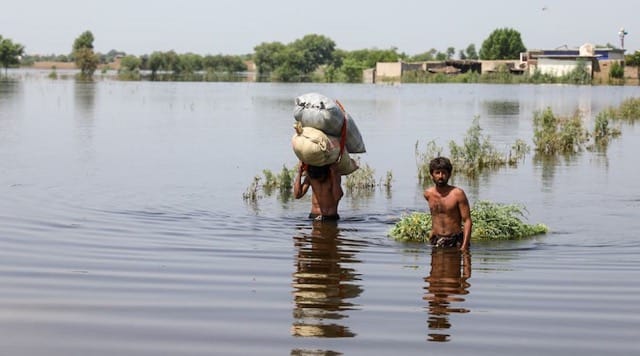Pakistan faces worst flooding in over a decade

Mahina Wasim, BA Politics
One-third of Pakistan is underwater. As of June 2022, Pakistan has been enduring severe monsoon weather which saw area-weighted rainfall 67 percent above normal levels in that month alone. Up until August 27th , rainfall was 2.9 times the thirty year average for the region . Severe flooding and landslides resulted from this, having detrimental effects on infrastructure, property, and human life. The Pakistani government has designated 72 areas as ‘calamity affected.’ Given the current rainfall, these figures are still fluctuating, and more districts are anticipated to be declared calamities.
Credit: macropakistan.com
Pakistan’s Balochistan and Sindh provinces, which are in the south and center, have been especially affected. As of 27 August, Balochistan has experienced 5.1 times its 30-year normal rainfall, while Sindh had recorded 5.7 times its average. Balochistan, Sindh, and south Punjab saw hill torrents, and most of Sindh’s districts were submerged with water, leading to mass destruction.
The Pakistani government calculates that 33 million of the country’s residents are impacted by the rains, floods, and aftereffects like landslides. Additionally impacted or in danger are the more than 421,000 refugees who reside in calamity-declared districts. About 6.4 million people were anticipated to be in need of assistance as of 27 August. The National Disaster Management Authority (NDMA) reported that between 14 June and 27 August, at least 1,033 people died and 1,527 were injured, with the number of casualties rising as the rainy season continued. More than 662,000 homes have sustained partial damage, compared to roughly 287,000 total losses. More than 719,000 livestock, a vital source of nutrition and livelihood for many families, have perished, with 69 percent of them dying in Balochistan and 28 percent in Punjab. 2 million acres of orchards and crops have also been impacted.
Infrastructure damage has had a significant negative impact and has exacerbated the humanitarian crisis. People’s ability to flee to safer locations has been hampered by damage to roughly 3,500 km of roads and 149 bridges, which has also jeopardized the distribution of help to those in need. The incapacity of the current infrastructure to handle the tremendous volume of water has further amplified flash floods and rain-induced landslides. Major dam reservoirs are rapidly filling or already overflowing, creating a significant risk to residents nearby and further downstream. Many rivers, including the Indus River, which runs the whole length of Pakistan, are at high flood warning levels and/or have exceeded their banks. There have also been reports of internet disruptions, with the Pakistan Telecommunications Authority attributing extensive internet cuts in central and northern Pakistan on 19 August to fiber optic network technical issues brought on by the intense rain and flooding.
Credit: UNICEF / Asad Zaidi
“Despite having a very low carbon footprint, Pakistan is one of the ten nations that are most vulnerable to extreme weather conditions, according to Climate Watch and the Global Climate Risk Index 2021.”
Despite having a very low carbon footprint, Pakistan is one of the ten nations that are most vulnerable to extreme weather conditions, according to Climate Watch and the Global Climate Risk Index 2021.“My ask is very simple. It is that climate-affected countries whose carbon footprint is less than 1% of global GHG emissions should not be having to bear the burden of other people’s contributions,” Senator Sherry Rehman, Pakistan’s minister for climate change said in an interview. “Here we are afflicted with an event catastrophe that nobody has seen before in living memory and we are bearing the burden of it pretty much on our own with some help from friends.” She has repeatedly stressed that the most significant factor contributing to the crisis is climate change.
According to data recorded and released by the NDMA, the 2010 floods, which affected 10 million people, this year’s floods hit more than 30 million people. Livestock damage in 2010 amounted to $0.27 million, whereas it has cost nearly $0.7 million currently and is likely to rise. In certain locations, 45% of crops had been lost, including the cotton crop, which is a major source of Pakistan’s GDP, as opposed to 11% in 2010. This has devastating economic reparations for the country, with climate change expected to only worsen over time. Even while national efforts to assist those impacted are already underway, international cooperation is essential to effectively handle the effects of the continuing rains and floods.





